
The BBC and Master Computer Public Domain Library
Elite
Page last fiddled with 16 April 2021
On This Page:
LinksPlatforms
Where to get Elite
Downloads
Comparisons
Reviews
Images and Video
Introduction
Elite by Ian Bell and David Braben is my all time favourite game on the BBC and Xbox (well, GTA runs a close second on the Xbox to be honest but that's irrelevant here. Don't know why I even mentioned it. Forget that..).I can still remember buying it in 1984 on tape in Smiths in Hull not knowing what I was getting. I just wanted a new game and bought it. It took a long time to load in to my BBC B but wow, was it worth it.
It caused me a lot of marital grief, playing it when I should have been doing other stuff. It was worth it though as I eventually became Elite.
The images and videos here are from my genuine and uncheated BBC save. Elite is a game I have never cheated at and that is saying something as I have hacked most games. Hacking was one of my favourite pastimes too.
I was blown away by the graphics and concept. A huge galaxy to free roam, but not only that, another 7 galaxies after that. It seemed massive, it was a really ground breaking game that still holds water today.
This page is my homage to it.
Links
For proper info go to Ian Bell's Elite website here. This should be the first place you jump to.Elite Manual on line
Mark Moxon's BBC Micro Elite source
Discussions here on Stardot. 8 bit Acorn software classic games topic.
A comparison of Elite versions on Stardot
Platforms
Electron. BBC Tape. BBC Disk. BBC Master. BBC Tube. Master Compact. Amiga. Spectrum. MSX. Tatsung Einstein. NES. C64. Apple II. Amstrad CPC. Atari ST. PC. PC Elite+. Archimedes. Added 08/11/2016: XBox One, and most game platforms.Where to Get BBC Elite
New BBC Disc/Tape Versions:Currently not available BUT watch this space. In the course of updating this page I spoke with Richard Hanson of Superior Interactive who mentioned that he is looking into the possibilities of re-releasing it.
Second Hand Originals
Go for silly amounts on Ebay
Emulator disc images. here
Elite on the PC
There are good versions of Elite now for the PC and XBox. Play the BBC version in an emulator, I prefer Beebem for this
Downloads
Ian Bell's Manual Page here.Original Manual Scanned PDF Read now. Or Download
Manual in a Word Document
Manual in HTML
Frequently Asked Questions
Quick Reference Text File
Function Key Strip
Disc and tape images, source files and lots of other goodies can be downloaded from Ian Bell's Elite page here
8BS Holds copies of the above stuff, just in case.
Elite Commander Editor Cheat. SSD Disc Image. From The Acorn User 2/86
Comparisons of The Acorn Versions of Elite
Electron Elite (Bell & Braben, 1984)
A version for the Acorn Electron, this is the simplest form of Elite.
It has the reduced ship selection, and no suns so the fuel scoop is only
useful for collecting cargo. The screen is monochrome, including the console,
and graphics are wireframe with hidden line removal. All space stations
are Coriolis model. There are no missions.
BBC Tape Elite (Bell & Braben, 1984)
This version has the reduced ship set. The space view is monochrome
with wireframe ships, as above, but the console is 4-colour (red, green,
and yellow or white depending on whether you had an escape pod) due to
a cunning trick allowing it to be in Mode 5 while the main view was in
Mode 4. All space stations are Coriolis model. There are no missions. One
interesting feature of this and of Electron Elite is the inability
to turn off the docking computers(!).
BBC Disk Elite (Bell & Braben, 1984, combined disk 1986 with
Master and Tube Elite)
Like BBC Tape Elite but with more ships, and when you dock on a space
station you get a brief view of other ships sitting around on the ground.
This is the archetypal classic Elite. Each sun has one planet and each planet has one space station but this may be Coriolis or Dodec class. Planets are occupied by a variety of races and have a variety of governments which act as danger classifications, from the tame Corporate States, through Democracies, Confederacies, Communist States, Dictatorships, Multi-Governments and Feudal Systems, to Anarchies, the worst of the worst.
The ships flew using an inertialess engine - the player controls speed, not thrust, and can change direction instantaneously.
The game uses the standard ship set.
The first batch of disks sold had a minor glitch which prevented asteroids from ever appearing. Boulders never appeared either, these are simply the fragments produced from shooting an asteroid with a mining laser and can be sold as minerals.
To display the authors' names on the spinning ship screen, pause the game, press X, then unpause again.
Missions
Hunt the Constrictor
A special prototype ship (the Constrictor) has been stolen. Last seen
at a planet whose name you are given. Hunt it down!
Triggered about 100 kills into Competent, after your first Right On Commander, in Galaxy 1 or 2. If in galaxy 2, you are simply told that the ship is believed to have hyperspaced into that galaxy. You just have to try and remember where galactic hyperspaces enter! (Or go round full circle, or just keep ambling around until you stumble onto the trail).
Starting in galaxy 1, travel to the planet and look at the data-on-system screen. You will see a message telling you where to go next. Follow the trail. The Constrictor will galactic-hyperspace. Follow, but remember he will have a full tank of fuel. When you emerge, note down all the planets in 7ly. You'll have to check them all to find out which he went to next!
When you track him down, you'll find he's a rather tough target. Either a prolonged laser duel will ensue, or you can get in really close and hit him with a missile before he can ECM it. The latter is easier, but far less satisfing, even if you do think it up yourself.
Thargoid Documents
Run some plans for an attack on the thargoids from one end of
the galaxy to the other, under attack all the time from them.
Triggered by being Elite in galaxy 3. Good for getting alien items! I was somewhat peeved to discover I had only been a decoy.
Elite - The Executive Edition (Bell & Braben)
A special BBC 6502SP version. The only difference I know between this
and normal BBC Disk Elite is that if you leave it on the spinning ship
start screen for long enough, a StarWars-type scrolltext begins to roll
up the screen.
BBC Master Elite
(Bell & Braben, 1984, 2nd release 1986, 3rd release 1986 on combination
disk with Tube and original BBC disk versions.)
The first Elite to have colour in its main display. The console is
drawn in eight colours and the main display in four (including black).
This version uses the standard ship set but also sports a peculiar craft
which is the second one displayed during startup when creating a new pilot.
According to Chris John Jordan, who was involved with the creation of Acornsoft's editions of Elite, it is the Cougar, an initially peaceful trader which fights very effectively when attacked and possesses better-than-average shields and laser. Ian Bell's WWW page noted the existence of the Cougar so it can be presumed that this is it.
Missions
I know little about this. I have heard it has more than the 2 of original
BBC Elite but I am unaware how many more. Apparently one is to track down
and destroy a Cloak and Dagger ship which has stolen a cloaking device
from the navy. This has been reported to be a (the?) Cougar. Any more information
on any missions would be greatly appreciated.
BBC Tube Elite
(Bell & Braben 1986, superseded by joint disk with Master and original
BBC, also 1986)
Designed to run on a BBC B or Master with second processor, this game appears identical to BBC Master Elite only faster. I would speculate that it also has the same missions, the Cloak & Dagger Ship and the Cougar. Note that the Cougar does not appear on the startup screens, however.
Master Compact Elite (Bell & Braben, 1984)
Existence of a special version designed for the Master Compact is rumoured
but has yet to be confirmed.
Elite A
(Bell & Braben, highly modified by A.Duggan, allowed for release
1997)
Using the Elite A unique ship set, this game is a non-commercial significantly
altered version of BBC Disk Elite. While the graphics are the same, many
features have been altered: The player begins as pilot of an Adder and
can buy better ships (this is _very_ expensive and seems likely to keep
me in a job right up to Elitehood!) as he earns more money. Ships have
different speeds, turn rates, numbers of missile pylons, shield and hull
strengths, laser mounts, hyperspace ranges and cargo hold sizes.
Equipment now occupies space so it is essential to strike a balance
between weaponry and trading space.
Other significant modifications include:
Special cargos, which must be delivered to a specific destination as
quickly as possible with payment depending on speed.
An online encyclopedia allowing access to ship statistics and pictures
(though I can't see how the value given as cargo space is derived - it
seems utterly erroneous on the Adder and Gecko, at least), equipment information
and keys. An IFF device allowing identification of ships' intents at a
distance. Random ship appearance positions, so you can't tell whether they're
pirates by their start location. Replacement of the vastly unfair energy
bomb with an instant hyperspace run away unit.
Many more less significant changes.
It runs in an enhanced mode with a Tube Coprocessor which is slightly faster, accesses the disk less and has more varied ship encounter combinations.
Missions
Because the game has only been made recently available to the public
(and that on the understanding that it is only used by those who have already
purchased a copy of Acorn Disk Elite for the BBC Micro) mission details
are unknown until someone plays through them. I can confirm that the first
BBC Disk Elite mission (hunt the Constrictor) is still in there - I'm
doing it now.
Reviews
Elite review from Beebug (scan). Thanks to Ali Campbell for this. Do 'BACK' in your browser after viewing thisElite Review by Crispin Boylan
Name: Elite
Price: £14.95 (£7 to 8BS Members)
Type: 3D Shooting/Trading/Space Flight Simulation
Available From: Superior Software
Well, there really isn't much to say about this game that hasn't been said before, unless you've been on Mars for a good fifteen years you will most definitely have heard of this game, possibly the most advanced game for its time this century. Created by the now infamous David Braben and Ian Bell, this is a space trading and shooting game, set far into the future where Space Travel is commonplace and nearly everyone makes their living by the stars. It is up to you, Commander Jameson, what you make of your career, you start in a fairly downbeat star system, with the lowest spec lasers and equipment, and 100 credits to your name. Your options at the start are fairly limited, either buy some items to trade with, or go out into the stars and shoot for a living. As you are ill-equipped for this sort of thing it is probably best to trade with other systems at first, then when you have the money to buy equipment for the ship, improve it so you have at least a fighting chance of winning!
It is this open endedness about the game which is so very appealing to almost everyone who plays it, there are no real rules of the game as such, you aren't told what you must do, you do what you feel like. If that means blasting the engines off of whatever comes near you then so be it, but if you so happen to shoot a police ship don't expect them to be too kind! The real technological achievement comes in two places in this game. Firstly the graphics used to portray the outside world are quite frankly superb for their age (1984), they consist of wire frame models using hidden line removal (i.e. they appear to be solid, a very difficult and processor intensive feature) and everything is modelled in 3D, be it Space Stations, planets or suns. The main screen consists of a window in which Mode 1 is used for black and white graphics, and Mode 4 for which 4 colours are used to display the text readouts such as fuel, status (green for clear, yellow for caution, and red if you are under attack). This is a novel idea, and works as it conserves memory as well. The second technological achievement is the game size, it is huge, there are 8 galaxies, each consisting of several hundred star systems, each with its own individual characteristics such as the technology level (higher means you can purchase more advanced systems for your craft) and the government type (meaning how the system is policed, obviously anarchy systems are full of pirates waiting to blow you out of the stars, but corporate states are very rich and well policed, meaning it is very unlikely that you will be shot at).
The game is very very hard at first, with you trading in whatever you can between star systems (the prices of different materials range depending on whether the system is agricultural or technological) and scrambling back to the space stations with your precious few credits. Ah..I didn't mention space stations did I? Well, this is also one of the hardest parts of the game, you have to dock with a rotating space station, getting your ship lined up with the part of it that you can enter through, then holding pattern with the rotation - it is very hard at first, and a Docking Computer is a wise move when you make your first 1000 credits or so! Once you move up though, get a few credits, you can try more risky actions, like trading in illegal substances (including radioactives and narcotics), or being a bit of a bounty hunter. Bounty Hunting is my favourite task in the game, one on one combat with the computer operated ships, if you destroy them then you get a certain number of credits, depending on how dangerous they were.
In the disk version of the game there are quite a few ship types to watch out for, the toughest being the Mambas and Kraits (real pirates ships) and the Boas and Pythons are the real cargo carriers which can be shot at and if you succeed in blowing them up you can have their cargo, as long as you have some fuel scoops to pick up the cannisters! Fuel Scoops I hear you say - yes, you can buy a lot of equipment in this game, depending on what job you want to do you may want to pick up better lasers, mining lasers (to turn the asteroids you find into smaller minerals to scoop up), more missiles, docking computers, energy bombs (wipes out everyone in the area except you) or escape capsules. This really gives you something to aim for in the first stages of the game, especially the docking computer - pure heaven when you get it!
Also included in the game is the Elite ranking system for combat, basically you start of as 'Harmless' but after shooting a couple of ships you may be regarded as 'Mostly Harmless', and so on right up to ELITE! For this though you must get about 6400 kills - believe me it is a lot of shooting! Other ranks you progress through are Poor, Average, Above Average, Competent, Dangerous and Deadly, it really is satisfying when you see your new ranking, and it takes a lot of work! Then of course there are the secret missions...but we won't go into those as I don't want to spoil it!
Anyway, this is superb fun, and it shows exactly what the Beeb is capable of, since 1984 this game has been ported to every format under the sun - and if you have an Archimides then that contains what is probably an even better version of Elite than this - but not by much! This of course is not the original release of the game, it was first released by Acornsoft, and ran on the BBC B only, but this new version contains enhancements if you have a Master (coloured ships, no loading from disk after initial loading) or a 2nd Processor (more advanced gameplay), which is great value for money! One thing I would say is that this new packaging lacks the Novella 'The Dark Crystal' originally supplied with the game, and although interesting it doesn't do much to enhance the game play or the already excellent Flight Training manual.
This game is a must - you really should play it if you haven't already!
Overall score: 95%
Images and Video
Commander Chris
My first flight for a few years, a bit ropey but gives a good insight into Elite on the BBC. Using a keyboard didn't help, there's pauses where I look at the crib sheet for key functions. I also cheat (Did I say I didn't cheat at Elite earlier? Well that's blown my credibility straight off. Well, I promise that the actual save is never updated after cheating. How's that?) at one stage and load in a saved state, oh and speed the emulator up a bit on the long sections it wouldn't jump. There is a lot of beeping where I am trying to do a quick jump but am thwarted by enemies and asteroids.Game Screenshots
Loading Screens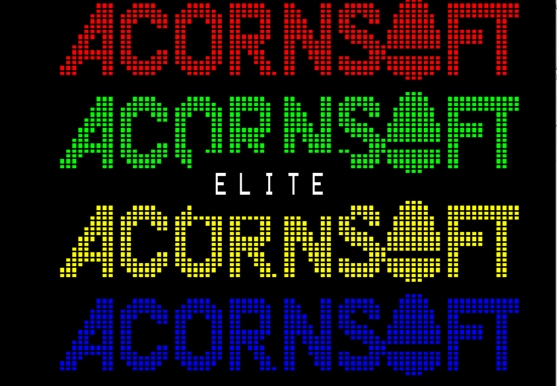
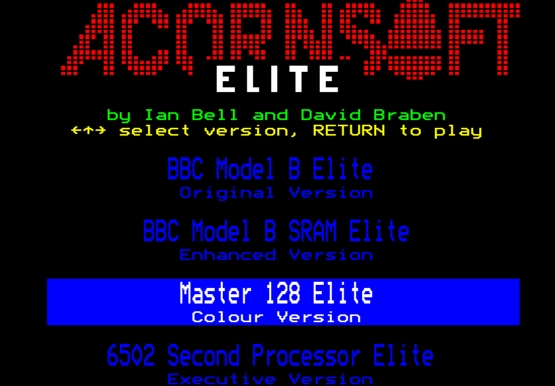
f8 Status Screen
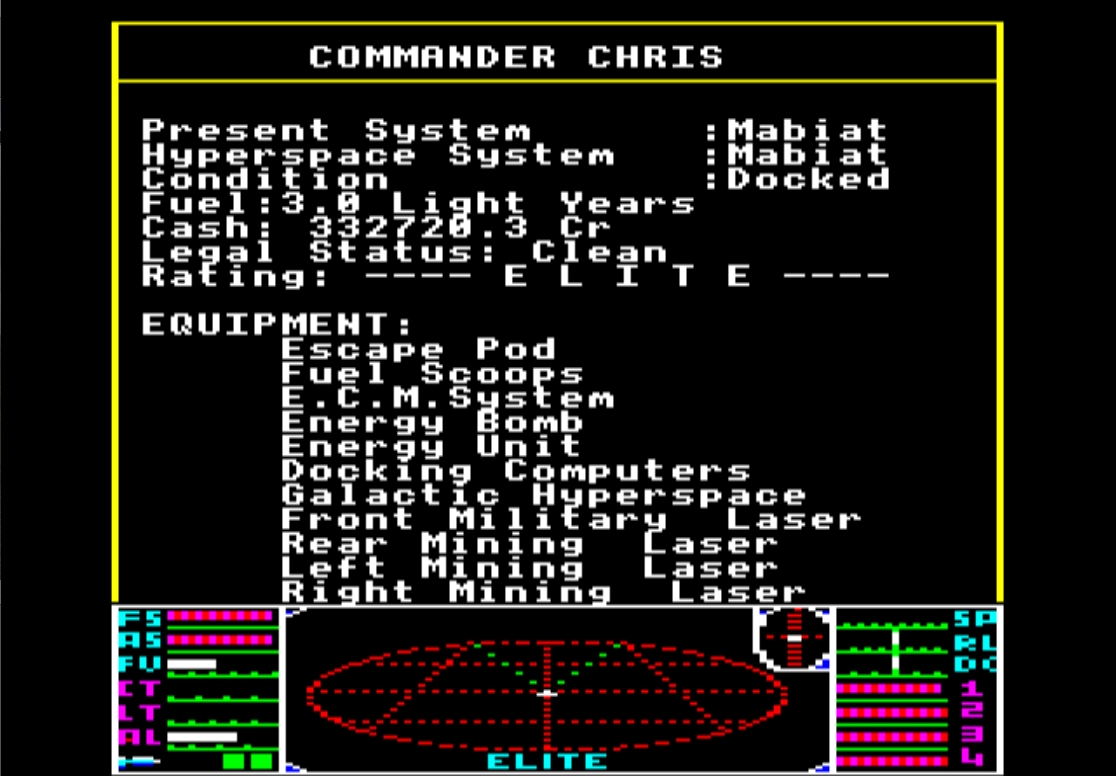
f5 Local Cluster showing distance fuel will take you
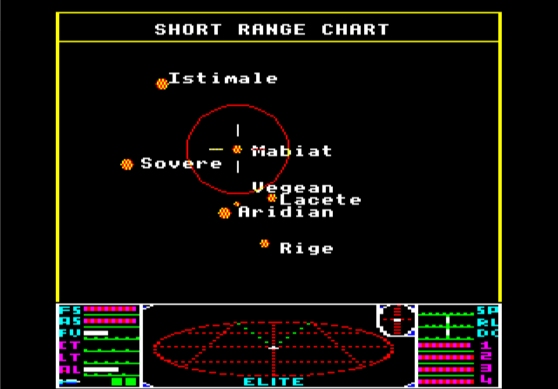
f4 Galactic Chart after refuelling

f1 Buy Cargo
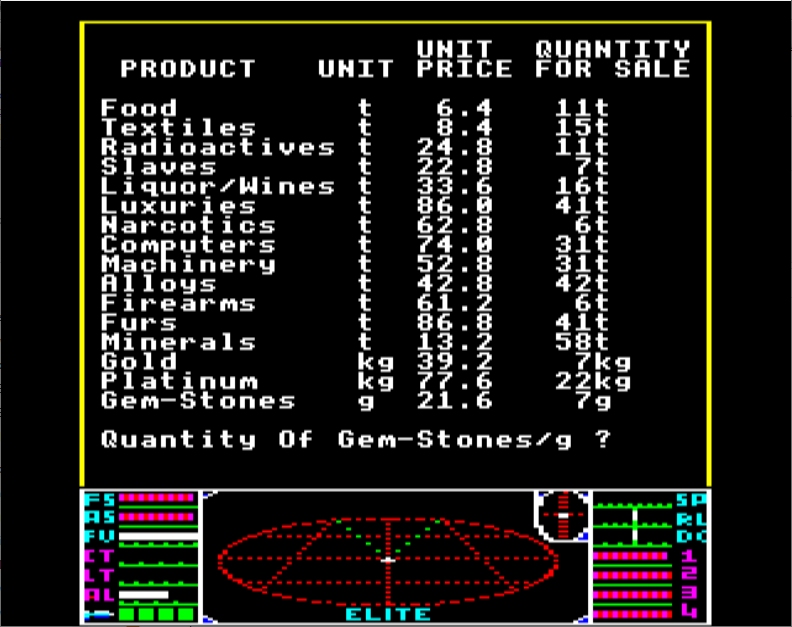
f3 Equip Ship Screen

f6 Data on System
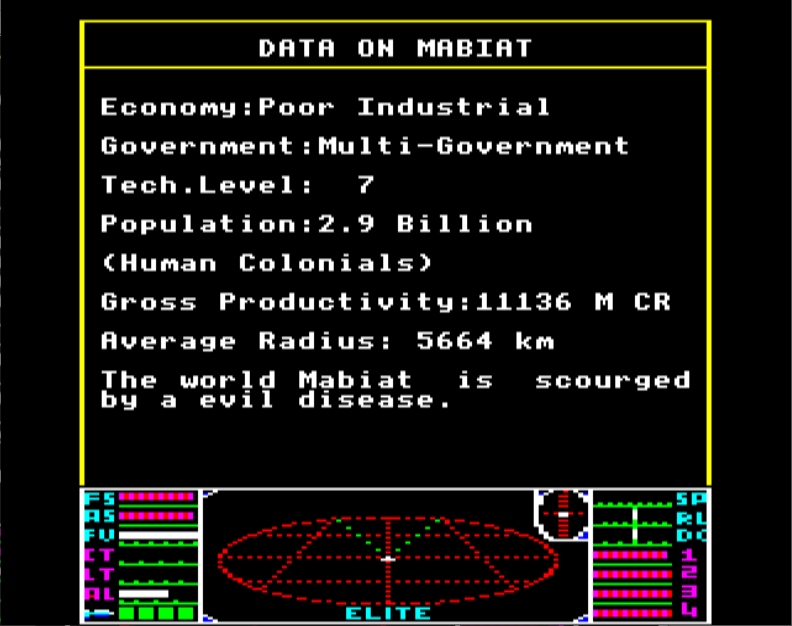
f7 Market Prices
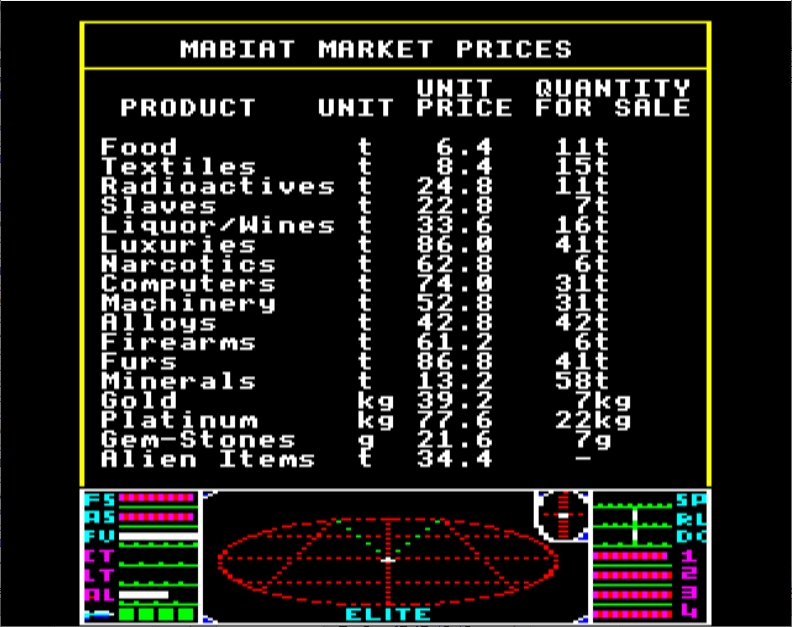
Thargoids
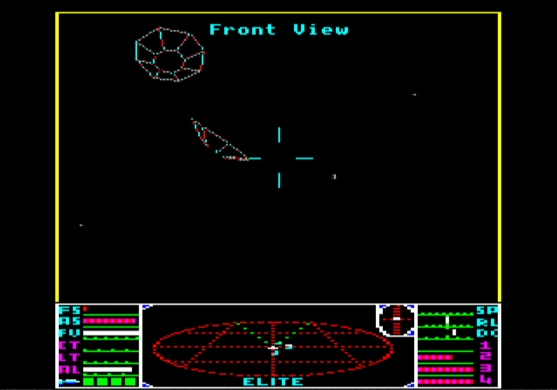
Having used the control+X thing whilst paused.
Ian Bell's Ship Designs